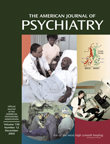Ten consecutive outpatients satisfying the criteria, who had been referred to and treated in the Affective Disorders Program of the University of Bologna in Italy, were enrolled in the study. The patients’ diagnoses were established by the consensus of two psychiatrists (G.A.F. and C. Rafanelli) independently using the Schedule for Affective Disorders and Schizophrenia
(4). Subjects had to meet the following criteria: 1) a relapse of major depressive disorder according to the Research Diagnostic Criteria (RDC)
(5) while receiving long-term antidepressant therapy (longer than 6 months); 2) relapse should not have been caused by compliance problems; 3) treatment had been initiated when the patient was in his or her third or greater episode of depression, with the immediately preceding episode being no more than 2.5 years before the onset of the current episode
(6); 4) no history of manic, hypomanic, or cyclothymic features; 5) no history of active drug or alcohol abuse or dependence or of personality disorders, according to DSM-IV criteria; 6) no history of antecedent dysthymia; 7) no active medical illness; and 8) successful response to antidepressant drugs administered by a psychiatrist. The 10 patients were treated with the following antidepressant drugs: 20 mg/day of fluoxetine (three patients), 15 mg/day of mirtazapine (three patients), 100 mg/day of amitriptyline (two patients), 50 mg/day of fluvoxamine (one patient), and 100 mg/day of desipramine (one patient). The mean duration of treatment was 9 months (SD=2). The mean number of depressive episodes was 4.3 (SD=1.3). Comorbidity consisted of generalized anxiety disorder (two patients), social phobia (one patient), and agoraphobia (one patient). There were four men and six women. The mean age was 44.3 years (SD=11.1). Written informed consent was secured from all patients. No patient declined to participate or dropped out of treatment.
All patients were assessed by a clinical psychologist (C. Ruini), who was blind to treatment assignment for all the duration of the study. She administered the change version of Paykel’s Clinical Interview for Depression
(7), encompassing 20 items, each rated on a 1–7-point scale. This scale is particularly sensitive in detecting change in treatment outcome and is suitable for detecting subclinical symptoms of affective disorders (7–9). The patients were randomly assigned to one of two treatment groups: 1) dose increase of antidepressant drug (50% increase with tricyclics and doubling of dose with the other antidepressants) and clinical management or 2) maintenance with the same dose of antidepressant and the addition of cognitive behavior therapy. Both treatments were administered by the same psychiatrist (G.A.F.), and therapy consisted of six 30-minute sessions, once every week. Clinical management consisted of reviewing the patient’s clinical status and providing the patient with support and advice, if necessary
(8). Cognitive behavior therapy consisted of use of cognitive restructuring for distorted views and maladaptive beliefs, exposure for phobic symptoms, lifestyle modification, and well-being therapy
(8,
9). After 6 weeks, the patients were assessed again with the Clinical Interview for Depression by the same clinical psychologist, who was blind to treatment assignment. They were also rated according to Kellner’s global rating of improvement
(10). Only the patients rated as “better” or “much better” according to this scale and showing at least a 50% reduction in score on the Clinical Interview for Depression were judged to be responders. The patients were then assessed 3, 6, 9, and 12 months after treatment. Follow-up evaluations consisted of a brief update of clinical and medical status, including any treatment contacts or use of medications. “Relapse” was defined as the occurrence of an RDC-defined episode of major depression.

